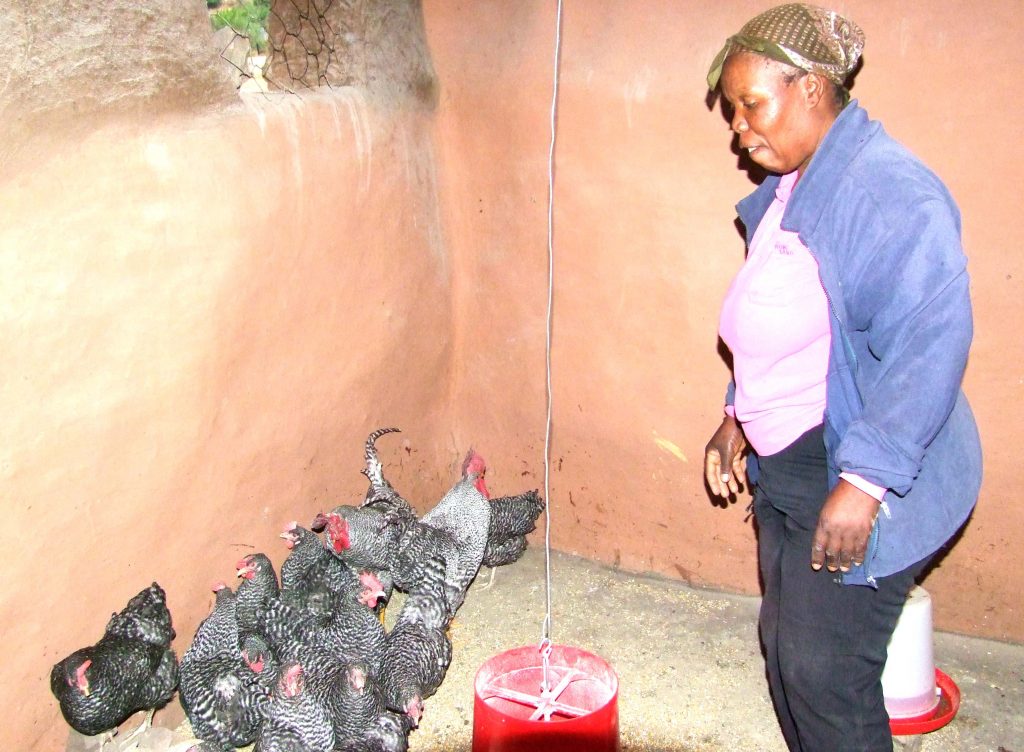Pascalinah Kabi
QUTHING – Hungry and not knowing where her two young children’s next meal would come from, Quthing single parent ‘Mafumane Mokhahlane eked out a precarious existence.
Unlike in the biblical story where manna fell down in the early hours of the morning for Israelites during their spiritual journey from Egypt to Canaan, it seemed there was never any respite to the suffering of Ms Mokhahlane and her small family.
Even odd jobs would rarely come her way despite spirited efforts to find the means to take care of her family.
As if that was not enough, the modest harvests from her subsistence farming that used to come to her rescue were gradually declining as the rapidly changing weather patterns took their toll on her village leaving her family hungry and stranded.
“I struggled to make a living for my family and the thought of my two children coming to ask where the next meal would come from tortured me and made my life a living hell,” the 49-year-old Ms Mokhahlane told the Lesotho Times on Tuesday.
“My husband left me with two young children aged 14 and eight years old, and it immediately became evident to me that I was in for torrid time in trying to feed and look after my children as an unemployed single mother.”
Unbeknown to Ms Mokhahlane, the changing weather patterns which had ravaged the fields had a silver lining for her and fellow Ha Rakhomo villagers in Quthing.
“I was selected as one of the beneficiaries of a poultry farming initiative in which we were given stress tolerant chickens called Bo-‘Malitśibana,” she said.
“Initially each one of us was supposed to receive 21 chickens but we ended up getting 17. Unfortunately, one of the 17 died and I am now left with 4 cocks and 12 hens,” Mokhahlane said.

Bo-‘Malitśibana is part of initiatives to reduce the impact of climate change. It is co-funded by the Lesotho government and United Nations agency Global Environment Facility and was implemented in 2011.
Under the project, Ms Mokhahlane and her fellow villagers have engaged in poultry and sheep rearing, conservation farming, preservation of grazing lands among other initiatives.
The project was also introduced to communities in Ha Damanyane, Quthing, Mafeteng and two villages in Thaba-Tseka, Maputsoe and Ha Tokho.
“The new chickens are easy to feed since they eat maize. They have changed my life from worse to better. I am now able to take care of my family’s basic needs by selling the eggs and also feeding them,” Ms Mokhahlane said.
“With the eggs I produce, I am able to sell each for M1.00 and that makes a huge difference in my life.
“The only expense I have incurred is in building separate chicken coops to house for the chickens. I must mention that the two types of chicken don’t mix at all.”
Ms Mokhahlane is also benefitting from community work for which she is paid M1 000 per month.
“I was again employed under the fato-fato project uprooting Sehala-hala (shrub) from craze fields and planting Tsahane (a grass),” she said.
Tsahane prevents soil erosion and allowing grass to grow rapidly.
Ha-Rakhomo Chief, Mohau Mokhahlane, said the project had not only helped his subjects to fight hunger but had also lowered the crime rate as well.
“Since these projects were implemented, our crime rate has decreased as people have found ways of making a living and probably no longer have time for such acts. We also have community policing programmes,” Chief Mokhahlane said.
“The projects have also made my life easier as most of my villagers would come running asking for food during hard times.”
The project’s Finance and Administration Manager ‘Mamokhomo Mabote said it was launched to address the challenges brought about by climate change.
She said the three districts in which the project has been introduced were chosen after being identified as “areas of chronic vulnerability” by the National Adaptation Programme of Action.
Ms Mabote said the ministries of Forestry, Range and Soil Conservation as well as Agriculture and Food Security consulted district administrators, chiefs and councillors who identified the most needy communities.
“Studies are underway to see what type of cropping is suitable per each district and community. Seeds like sorghum, maize and others have already been tried out and the ministry of agriculture is yet to complete and issue a report,” Ms Mabote said.
Asked why the projects were only coming to light now despite being launched in 2011 and ending in December 2015, she said: “It is only now that the media is being informed about these projects.”
Ms Mabote said there were many success stories from the project, namely Forestry ministry’s assessment of the vegetation and livestock per village.
“After this, the ministry drew a grazing plan for each community based on the number of livestock they had, and it is working wonders in Ha Rakhomo village as more grazing land which had become arid has been rehabilitated,” she said.
Ms Mabote said although the project was coming to an end soon, the beneficiaries were supposed to continue. She also noted that there were three automated weather stations in Quthing, Mafeteng, Thaba-Tseka, Leribe, Berea and Maseru.
“We have also trained meteorologists and observers who will directly work on these stations and help forecast the weather conditions in Lesotho,” Ms Mabote said.
She added that they had formed a national climate change committee made up of different ministries, non-state actors and farmers’ associations.
“The purpose of the committee was simply to create a platform to discuss government initiatives on climate change and help in developing Lesotho’s first climate change policy,” Ms Mabote said.


